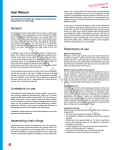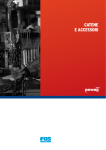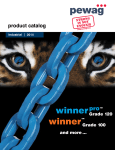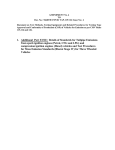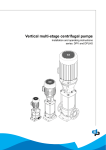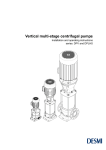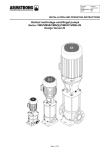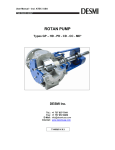Download User manual
Transcript
Transportutstyr AS Phone/Tlf.nr.: +47 63 87 10 80 [email protected] www.transportutstyr.no User manual for stainless steel chain system 27 27 User manual Transportutstyr AS Phone/Tlf.nr.: +47 63 87 10 80 [email protected] www.transportutstyr.no User manual Information for use, storage and maintenance of pewag winner inox chain slings General pewag winner inox lifting accessories can be used for general lifting purposes covering a wide range of designs, loads and slings. Detailed information of all chain, components and chain slings are given in this catalogue and follow the Uniformed Load Method of Rating as standard. In addition, there is also an alternative method of rating the capacity of chain slings (Trigonmetric Method). This method should only be used where the weight and distribution of the load and the angles of the chain sling legs are known, and when the lift has been carefully planned and is supervised by a competent person. In such applications please contact our technical department, as the information given in this catalogue does not include details on chain sling rating using this alternative method of rating! Chain slings shall be used only by trained personnel. If properly used, pewag winner inox chain slings have a long service life and offer a high degree of safety. Personal injury and damage to property can only be prevented by proper use. It is therefore highly important that you read and understand this user information and act in a responsible and forward-thinking manner when using lifting equipment. Limitations on use When modifying or repairing pewag winner inox chain slings use only pewag supplied original parts (e.g. bolts, safety pins, screws, etc.). The shape of the slings must not be modified – e.g. by bending, grinding, separating individual parts, drilling, etc. Avoid heating of the chains to more than 700°C. Do not remove any safety components, such as safety latches, safety pins, etc. Do not apply any surface coatings to pewag winner inox chain slings, i.e. do not subject them to hot galvanizing or electrogalvanizing. Dipping or removing the coating with chemicals is also dangerous and must be agreed upon by pewag. If required please contact our technical department who will be pleased to provide information. Restrictions of use due to hazardous or dangerous conditions (see table on page 13 of catalogue) Temperature The reduction of load capacity caused by high temperatures, as stated on page 13, ceases once the chain and/or lifting component reaches room temperature again. pewag winner inox lifting accessories must not be used outside the stated temperature range. In the event of temperatures outside this range, do not use the chain slings, and remove from service.. 28 pewag winner inox stainless steel chain system G5 Acids, caustics and chemicals Do not subject pewag winner inox lifting accessories to acid or caustic solutions or in acid or caustic-laden atmospheres. Important: Certain production procedures release acids and/or fumes. Use of pewag winner inox lifting accessories in highly concentrated chemicals in combination with high temperatures is only allowed upon explicit prior approval. Working load limit The working load limits in this catalogue and those on the chain sling have been determined on the basis that the loading of the chain sling is symmetrical and there are no particularly hazardous conditions. Such hazardous conditions would be offshore applications, the lifting of people and potentially dangerous loads, such as liquid metals, corrosive or caustic substances or nuclear material. If the chain sling is to be used for such purposes, the extent of the risk is to be assessed by an expert and the safe working load be adjusted accordingly (see page 13 for recomendations). Inspections and tests Before using any lifting equipment for the first time, it should be ensured that: • The chain sling corresponds exactly to the order; • The inspection certificate or certificate of conformity has been supplied; • Marking and load capacity stated on the chain correspond to the information given on the inspection certificate or certificate of conformity; • All particularities of the chain sling have been entered into a register of lifting equipment, if required; • Instructions for the proper use of chain slings has been supplied, read and understood by personnel. Check the chain slings before each use for visible damage or signs of wear. In case of doubt or damage do not use the chain slings and have them inspected by a competent person. After extraordinary, events that could cause impairment of the chain sling, the chain sling must be checked by an expert (e.g. after exposure to uncontrolled heat). As per EN818 we recommend subjecting the chain sling every two years to a load test with 1.5 times the load capacity, followed by a visual inspection, or another type of crack test (fluxing). Elimination criteria following visual inspection • Broken part • Missing or illegible marking of the chain sling, i.e. identification data and/or load capacity data • Deformation of suspension or sling parts or the chain itself • Elongation of the chain. The chain must be discarded if t > 1,05 tn • Wear is determined as the mean value of two measurements of diameters d1 and d2 carried out at a right angle (see picture). The chain must be discarded if dm = d1 + d2 < 0,9 dn 2 Transportutstyr AS Phone/Tlf.nr.: +47 63 87 10 80 [email protected] www.transportutstyr.no User manual Correct use of pewag winner inox chain slings Angle of inclination – sling points Select slinging points and chain type in such a way that the angles of inclination of all chain strands (legs) lie within the data given on the identification tag. All angles of inclination should preferably be the same. Avoid angles of inclination of less than 15°, because of the high risk of load instability. Never use chain slings with the angle of inclination exceeding 60°. • Cuts, notches, grooves, surface cracks, excessive corrosion, discoloration due to heat, signs of subsequent welding, bent or twisted links or other flaws. • when wear a chemical abrasion (example pitting) or a permissable wear tolerance has been reached per the table attached. • Cracks: Chains with cross-cracks that are visible to the naked eye must be discarded. • Missing or non-functional safety device (safety latches if fitted) as well as signs of widening or twisting of hooks, i.e. noticeable enlargement of the opening or other forms of deformation. The enlargement of the opening must not exceed 10 % of the nominal value. A jumped out safety catch shows an overload of the hook. Edge load – protection of load and chain The maximum load capacity of pewag winner inox chain slings was defined under the assumption that the individual chain legs are pulled straight under load, i.e. that they do not run over edges. In the case of edge loading, load protection (packing) should to be used to avoid damage. For correct and incorrect use see Maximum approved dimensional change: Designation Dimensions Admissible deviation Chain dm -10% t +5% d -10% t +10% e +5% d2 and h -10% g +10% halves loose no changing admissible e +5% c -10% Links Hooks CWI Shackles Connex bolt Bolzen beweglich no changing admissible e +5% d, d1, d2 und M -10% d -10% Repair pewag winner inox lifting accessories and chain slings should only be repaired by qualified personnel using genuine pewag parts. Documentation Records of inspections, and in particular their findings, as well as details of repairs carried out must be kept on file during the entire service life the chain sling. Storage pewag winner inox sling chains should be stored in cleaned and dried condition and protected from corrosion, e.g. lubricate stainless. If chains are guided over edges without proper protection, their load capacity is reduced. For the corresponding load factors please refer to the table on page 13. But if chains looped around a beam or other round shaped loads the diameter should be minimum 3 times the chain pitch. For smaller diameters the WLL of the chains must be reduced by 50%. Impact The maximum load capacity of pewag winner inox chain slings are defined under the assumption that the load on the individual chain strands (legs) is applied without any impact or shock loading. In cases of possible impact/shock, the load factors on page 10 must be taken into consideration. Impact/shock is defined as follows: • Slight impact: created, for example, when accelerating the lifting or lowering movement • Medium impact: created, for example, when the chain slips when adjusting to the shape of the load • Strong impact: created, for example, when the load falls into the unloaded chain Vibrations pewag winner inox lifting chains and components are approved dimensioned for 20.000 cycles. In case of high dynamic stress there is a risk of damage. According to the „Berufsgenossenschaft Metall Nord Süd“ the stress at load capacity limit can be reduced by using higher dimensioned chains and components. Symmetrical loading The load capacities of pewag winner inox chain slings are defined with the assumption that the load of the individual chain strands (legs) is symmetrically distributed. Lifting of the load then leads to identical angles of inclination, and the individual strands (legs) are symmetrical to each other. pewag winner inox stainless steel chain system G5 29 User manual Transportutstyr AS Phone/Tlf.nr.: +47 63 87 10 80 [email protected] www.transportutstyr.no The load can still be considered symmetrical when the following conditions are met: • The load is smaller than 80 % of the stated load capacity (WLL). • The chain sling leg angles to the vertial are all not less than 15°. • The angles to the vertical of all chain legs are identical or deviate max. 15° from each other. • In the case of three and four strand sling chains, the corresponding plan angles are within 15° of each other. Example of asymmetry If all of the listed parameters are not met, load is considered to be asymmetric and an expert must be called in to assess the lifting process. In case of doubt, only one chain strand (leg) should be considered as load-bearing. For the corresponding load capacity please refer to the load capacity table. Use of pewag winner inox chain slings for other than the intended purposes Use chain slings only for the intended purpose. In cases where not all individual strands (legs) are used simultaneously or where several chain slings are used at the same time, please refer to the load capacity table to find out the load capacity. In case of doubt or as an alternative, change the load capacity according to the following table. Type of chain sling Number of individual strands used Use factor in relation to the load capacity given on the tag. two-stranded (2-leg) 1 1/2 tree- and fourstranded (3/4 leg) 2 2/3 tree- and fourstranded (3/4 leg) 1 1/3 2x single stranded (single leg) 2 1,4 up to 0°–45° 2x two-stranded (2 leg) 3 or 4 1,5 up to 0°–45° and 45°–60° Hang any individual strands (leg) that you do not use, back into the master link to prevent hazards caused by freely swinging chains or unintended hooking. Before using several chain slings at the same time, make sure that the crane hook is big enough for all the master rings. Make sure that the master rings cannot fall out of the hook during lifting. No angles of inclination of more than 45° allowed. Use only chain slings of the same nominal thickness and grade at the same time. Detailed user manual available for download on www.pewag.com The majority of the load is carried by 1 strand (leg) 30 The majority of the load is carried by 2 strand (leg) pewag winner inox stainless steel chain system G5 Transportutstyr AS Phone/Tlf.nr.: +47 63 87 10 80 [email protected] www.transportutstyr.no User manual Resistance Values for resistance in different media Material no. DIN-shortname Cr % Ni % Mo % Ti 1.4571 (AISI 316 Ti) X6 CrNiMoTi 17 12 2 16,5 - 18,5 10,5 - 13,5 2,0 - 2,5 Addition 1.4404 (AISI 316 L) X2 CrNiMo 18 10 16,0 - 18,0 10,0 - 13,0 2,0 - 2,5 - Corroding media Concentration % Temperature °C Atmosph. corrosion* Benzine Formic - acid HCOOH 10-50 80 Ammonia NH4OH Ammoniumnitrat NH4NO3 hydrous, cold saturated solvent Resistance Corroding media Concentration % Temperature °C Resistance 0 Nitric acid HNO3 1-90 50 20 boiling 0 1 Hydrochloric acid HCI 0,2-0,5 20 50 20 50 20-50 0P 1P 0P 1P 1P boiling 20 80 boiling 20 50 boiling 20 50 80 boiling 0 0 1 1 0 1 2 0 1 2 2 20 / boiling 0P 20 / boiling 0 20 boiling 20 boiling 0 1 0 3 20 / boiling 0 20 / boiling 0 Chloride hydrous solvent 20 1-3 P Acetit-acid CH3COOH 10 10-50 80 20 boiling boiling 0 0 1P 150 0 Fatty-acid (oil) Hydrofluoric acid 10 40 20 20 2P 3 Tannic-acid 50 20 / boiling 0 Potassium hydroxide KOH hot saturated 120 1S Lime milk Ca(OH)2 (Calciumhydroxid) 20 / boiling 0 Seawater 20 boiling 0P 1 20 boiling boiling boiling 0 1 2 3 Phosphor-acid H3PO4 1 50 80 concentrated A mesurement for corrosion - constant corrosion over the complet space is required - results from the weight - difference of the mat. after a certain time, weight before and after the corrosion. The loss of weight will be shown in gramm/m² and hour. This figure approx. corresp. the denutation mm/year. Exact compulsary details only after corresp. tests for exact defined corrosion causing chemicals without pollusion. Used in: Food-sector (dairy, slaughtery etc.) chemical industrie and in many fields of lifting, conveying and securing. 1 2 Sulfuric acid H2SO4 0,1 1 5 10 Trichlorethylene CHCI:CCI2 * The complete resistance depends on kind, composition and the water-content of the atmosphere and is in industrial areas and near the coast considerably less than in the highlands or in dry regions. 0 = completely resistent 1 = practically resistent 2 = little resistent 3 = theoretically non-resistent P = pitting S = stress corrosion g/m2h 0 corresp. to a weight-loss up to 0,1 1 corresp. to a weight-loss from 0,1 - 1,0 2 corresp. to a weight-loss from 1,0 - 10,0 3 corresp. to a weight-loss over 10,0 completely non-resistaned - pewag winner inox stainless steel chain system G5 31






